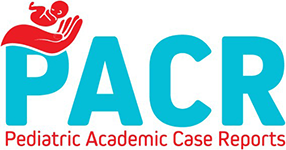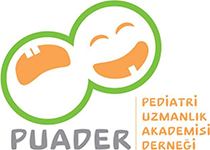Dysmotility In Gastrointestinal And Urinary Tract In A Neonate; Megacystis-Microcolon-Intestinal Hypoperistalsis Syndrome; A Case Report
Özge Serçe Pehlevan1 , Mehmet Baha Aytaç1
, Mehmet Baha Aytaç1 , Ayşe Nihan Uslan1
, Ayşe Nihan Uslan1 , Semih Metin2
, Semih Metin2 , Onursal Varlıklı2
, Onursal Varlıklı2 , Ayla Gunlemez1
, Ayla Gunlemez1
1Kocaeli University School Of Medicine, Department Of Pediatrics, Kocaeli, Türkiye
2Kocaeli University School Of Medicine, Department Of Pediatric Surgery, Kocaeli, Türkiye
Keywords: Bladder, dysfunction, dysmotility, intestine, microcolon
Abstract
Megacystis-Microcolon-Intestinal Hypoperistalsis Syndrome (MMIHS) is a rare disorder characterized by smooth muscle dysfunction impairing the intestine and bladder. This disorder is commonly associated with a fatal prognosis. Here, we present a female neonate with antenatal clues who had abdominal distension since birth and underwent multiple exploratory laparotomies, and bladder distension requiring drainage by catheterisation. Unresponsive surgical procedures for bowel decompression were carried out. She was managed with total parenteral nutrition and jejunostomy. Mutation in the smooth muscle gamma-actin (ACTG2) gene confirmed the diagnosis. A timely high index of suspicion is crucial for neonates, especially females with abdominal and urinary distension. The early multidisciplinary assesment of the patient provides appropriate treatment modalities, and improves the survival.
Introduction
Megacystis microcolon intestinal hypoperistalsis syndrome (MMIHS) is a rare congenital bladder and bowel motility disorder (1-4). It is characterized by a distended abdomen caused by a dilated but nonobstructed bladder, microcolon, and decreased intestinal peristalsis (1-4). The prognosis of MMIHS varies based on age, symptom severity, and accompanying medical conditions.. Although the disease has a high mortality rate in the first year of life, patients with less severe clinical variation may achieve longer (1-4). The majority of patients with MMIHS are dependent on total parenteral nutrition (TPN) and die from overwhelming sepsis and/or terminal renal insufficiency (2,3). Multiorgan transplantation remains the only definitive treatment for MMIHS (2-4). This report highlights the importance of early diagnosis and multidisciplinary care by presenting a neonate who tragically passed during the postnatal period.
Case Report
A female infant was born as the second survivor from the second pregnancy of a 28-year-old mother of a non-consanguineous marriage, at the 37th gestational week, weighing 3050 grams by cesarean section due to preeclampsia. The APGAR scores were 8 and 10 in 1–5 min, respectively. The mother was followed up for obesity and gestational diabetes. The newborn had bilateral hydronephrosis and bladder dilatation antenatally. She had inability to void, requiring catheterisation after birth spontaneously. Renal ultrasound, performed within the first postnatal week, revealed bilateral grade 2 hydronephrosis. The kidney function tests were unremarkable. Detection of bladder trabeculation by voiding cystourethrography was interpreted as the neurogenic bladder (Figure 1). The patient had suffered from bilious emesis since birth. Fluoroscopic gastrointestinal series with barium enema revealed no passage of contrast medium to the distal intestine within 50 min. Twenty-four-hour images were consistent with a hypofunctional distal colon (Figure 2). Therefore, the patient underwent exploratory laparotomy at the age of four days. The initial diagnosis was malrotation, and a jejunostomy was performed. Fewer ganglionic cells were shown on histopathological examination of the appendix. Stenotic segments of the terminal ileum and globe vesicle were found at the second operation performed due to intraabdominal adhesion on the 22th day. The patient did not tolerate enteral feeding during hospitalization. After the detection of an enlarged neurogenic bladder with mild trabeculated wall and ureterocele on the superolateral side of the right ureteric orifice by cystoscopy, a nephrostomy was planned. Nevertheless, the patient, who had suffered from recurrent sepsis and urinary tract infections, died during nephrostomy planning. Determination of a pathologic variant in the smooth muscle gamma-actin (ACTG2) gene confirmed the diagnosis of MMIHS after she died.
Discussion
MMIHS is a rare disorder involving smooth muscle function that impacts the urinary and gastrointestinal systems (1-3). The usual clinical findings of MMIHS include prenatal enlarged bladder, gastrointestinal pseudo-obstruction, and long-term dependence on TPN and urinary catheterization (1-3). Our patient,presenting with antenatal bilateral hydronephrosis and bladder dilatation, exhibited severe abdominal distension and bilious vomiting postnatally. Clean intermittent catheterisation was performed to manage bladder dysfunction in the postnatal period. As in our patient, these neonates undergo repeated abdominal surgeries and suffer complications of TPN, malnutrition, as well as infectious complications from enterostomies and catheters (1,2).
Approximately 25% of the patients were diagnosed antenatal, with the majority having a family history (3). Unfortunately, our patient did not have a positive family history, which led to suspicion of the disease in the postnatal period and later. Fetal megacytis and hydronephrosis with normal or increased amniotic fluid are the common findings in antenatal ultrasounds (5). Consistently, our patient had bilateral hydronephrosis and bladder dilatation antenatally. The amniotic fluid volume was not affected during pregnancy. Enzymatic analysis in amniotic fluid, and magnetic resonance imaging are other antenatal diagnostic options (6).
The exact pathophysiology of the disease is currently unknown (5). There is a female predominance in MMIHS, as in this case (2). A female-to-male ratio of 4:1 has been reported (4). Autosomal dominant or sporadic inheritance patterns with heterozygous mutations, as well as autosomal recessive inheritance, have been reported (5). In addition, heterozygous variants in the ACTG2 gene are related to sporadic cases, myosin heavy chain 11 (MYH11), leiomodin 1 (LMOD1) and myosin light chain kinase (MYLK) are related to autosomal recessive inheritance (7). These genes encode proteins that participate in smooth muscle contraction (5,7). In light of these variable genetic patterns, the prognosis has not been well clarified. In our case, a heterozygous mutation of the ACTG2 gene confirmed the diagnosis.
To date, no specific treatment for MMIHS has been established, and patient management remains a challenge. Recurrent urinary tract infections, vesicoureteral reflux, and hydronephrosis commonly result in renal failure which is the major cause of death. A bladder-emptying strategy, such as clean intermittent catheterization, suprapubic tube placement or vesicostomy, is useful to prevent upper urinary tract deterioration (8). Prophylactic antibiotics are also used to decrease recurrent urinary tract infections. Beside microcolon and intestinal dysmotility, gastrointestinal comorbidities like malrotation and complications, including short bowel syndrome and chronic intestinal pseudo-obstruction, are common gastrointestinal manifestations. Short-term and long-term management options are available for gastrointestinal symptoms. Enterostomies are common options to decompress the intestinal tract (1-4). However, surgical interventions did not improve intestinal pseudo-obstruction. Prokinetic drugs and gastrointestinal hormones are also ineffective. Only rare cases with de novo mutations in ACTG2 showed a clinical response to cisapride, a serotonergic 5HT4 agonist (9). To date, due to severe cardiac side effects, cisapride is not available in most countries, as in our country. Due to the unresponsiveness of gastrointestinal motility to treatments, patients do not tolerate enteral nutrition, and they are dependent on TPN. This condition leads to life-threatening complications, such as hepatotoxicity, cholestasis, malnutrition, and central line infections (1). Recent advances in the management of TPN, including strict monitoring and cycling TPN, switching to fish oil-based lipid emulsions to prevent TPN cholestasis, encouraging oral feeding, and lock therapy to prevent central venous catheter-associated bloodstream infection improve survival rates (10). The only longer-term valuable therapeutic solution is isolated intestinal or multivisceral transplantation especially who have continous nutritional failure, intolerable to TPN or inability to maintain central venous access (1-4,11). Therefore, decisions regarding surgical interventions should be individualized for each patient.
Improvements in TPN management and intestinal transplantation extend life expectancy to the second decade of life (11). Our patient suffered from sepsis, followed by multiple organ failure and poor nutrition, which was one of the most frequent causes of death in patients with MMIHS. Bacterial overgrowth and translocation secondary to malrotation, short-bowel, and catheter-related infections probably led to sepsis.
In conclusion, when dysfunctinal obstruction of the intestine and bladder occurs in a neonate, especially female ones, a diagnosis of MMIHS should be considered. Early diagnosis to optimize the timing of treatmant options, use of strategies to minimize complications of long-term TPN, and multidiciplinary management improve outcomes.
Cite this article as: Serce Pehlevan O, Aytac MB, Uslan AN, Metin S, Varlikli O, Gunlemez A. Dysmotility In Gastrointestinal And Urinary Tract In A Neonate; Megacystis-Microcolon-Intestinal Hypoperistalsis Syndrome; A Case Report. Pediatr Acad Case Rep. 2025;4(2):29-32.
The parents’ of this patient consent was obtained for this study.
The authors declared no conflicts of interest with respect to authorship and/or publication of the article.
The authors received no financial support for the research and/or publication of this article.
References
- Hashmi SK, Ceron RH, Heuckeroth RO. Visceral myopathy: clinical syndromes, genetics, pathophysiology, and fall of the cytoskeleton. Am J Physiol Gastrointest Liver Physiol 2021; 320: 919-35.
- Murali K, Dhua AK. Megacystis microcolon intestinal hypoperistalsis syndrome (MMIHS): challenges in diagnosis and management. BMJ Case Rep 2024; 17: e259983.
- Wymer KM, Anderson BB, Wilkens AA, et al. Megacystis microcolon intestinal hypoperistalsis syndrome: Case series and updated review of the literature with an emphasis on urologic management. J Pediatr Surg 2016; 51: 1565-73.
- Lim J, Hua J, Arcement C. Imaging findings of a twin male neonate with megacystis microcolon intestinal hypoperistalsis syndrome. Radiol Case Rep. 2021; 16: 628-30.
- Devavarapu PKV, Uppaluri KR, Nikhade VA, et al. Exploring the complexities of megacystis-microcolon-intestinal hypoperistalsis syndrome: insights from genetic studies. Clin J Gastroenterol 2024; 17: 383-95.
- Garel C, Dreux S, Philippe-Chomette P, et al. Contribution of fetal magnetic resonance imaging and amniotic fluid digestive enzyme assays to the evaluation of gastrointestinal tract abnormalities. Ultrasound Obstet Gynecol 2006; 28: 282–91.
- Moreno CA, Sobreira N, Pugh E, et al. Homozygous deletion in MYL9 expands the molecular basis of megacystis-microcolon-intestinal hypoperistalsis syndrome. Eur J Hum Genet 2018; 26: 669-75.
- Pellegrino C, Barone G, Capitanucci ML, et al. Megacystis-Microcolon-Intestinal Hypoperistalsis Syndrome: Don't Forget the Bladder. Pediatr Surg Int 2024; 40: 124.
- Wangler MF, Gonzaga-Jauregui C, Gambin T, et al. Heterozygous de novo and inherited mutations in the smooth muscle actin (ACTG2) gene underlie megacystis-microcolon-intestinal hypoperistalsis syndrome. PLoS Genet 2014; 10: e1004258.
- Prathapan KM, King DE, Raghu VK, et al. Megacystis Microcolon Intestinal Hypoperistalsis Syndrome: A Case Series With Long-term Follow-up and Prolonged Survival. J Pediatr Gastroenterol Nutr 2021; 72: 81-5.
- Hugar LA, Chaudhry R, Fuller TW, et al. Urologic Phenotype and Patterns of Care in Patients With Megacystis Microcolon Intestinal Hypoperistalsis Syndrome Presenting to a Major Pediatric Transplantation Center. Urology 2018; 119: 127-32.





